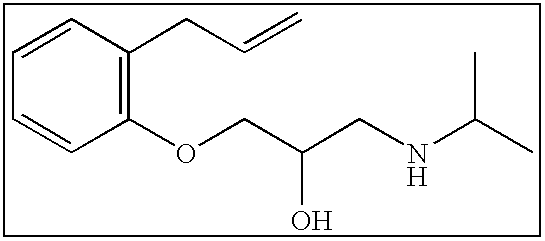In vitro method for determining drug permeability using immobilized artificial membrane chromatography
a technology of immobilized artificial membrane and chromatography, which is applied in the direction of chemical analysis using titration, component separation, material testing goods, etc., can solve the problems of poor replacement of other in vivo or in vitro methods of testing drug permeability, methods of little use, etc., and achieve high throughput, convenient, and high efficiency
- Summary
- Abstract
- Description
- Claims
- Application Information
AI Technical Summary
Benefits of technology
Problems solved by technology
Method used
Image
Examples
examples
[0054] The inventors used 21 reference compounds having a single positive charge at the pH at which the chromatography was performed, each having a published known permeability value, Pm, as determined by a Caco-2 cell assay by the various methods set out in references 1-7, below. The conditions used to determine the Caco-2 Pm values were generally similar in the cited references, although certain conditions varied between assays. Generally, the assays were performed at pH 7.4, with the exception of procaine and sumatriptan, for which the pH was 5.5 and 6.5, respectively. Therefore, for the experiments set out below, the pH of the mobile phase was 7.4 for all compounds except procaine (pH 5.5) and sumatriptan (6.5).
TABLE 1Reference CompoundsPm of Caco-2 AssayPublishedCompoundStructure(10−6 cm / s)ReferenceAcebutolol0.51 + / −0.021Alprenolol25.3 + / −7.01Atenolol0.53 + / −0.071Atropine19.50 + / −1.373Clonidine21.8 + / −3.01Desipramine101.17 + / −2.473Diltiazem29.8 + / −0.24Imipramine55.05Labetalol...
PUM
| Property | Measurement | Unit |
|---|---|---|
| v/v | aaaaa | aaaaa |
| v/v | aaaaa | aaaaa |
| pKa | aaaaa | aaaaa |
Abstract
Description
Claims
Application Information
 Login to View More
Login to View More - R&D
- Intellectual Property
- Life Sciences
- Materials
- Tech Scout
- Unparalleled Data Quality
- Higher Quality Content
- 60% Fewer Hallucinations
Browse by: Latest US Patents, China's latest patents, Technical Efficacy Thesaurus, Application Domain, Technology Topic, Popular Technical Reports.
© 2025 PatSnap. All rights reserved.Legal|Privacy policy|Modern Slavery Act Transparency Statement|Sitemap|About US| Contact US: help@patsnap.com



